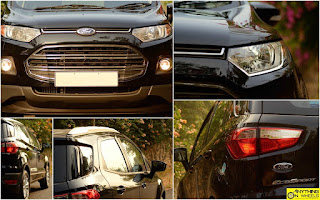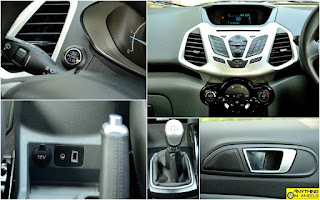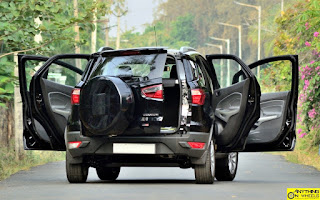When Ford launched the Ecosport in 2013, it took the Indian market by storm. Why not? It had the perfect recipe that Indians were waiting for - snazzy 'SUV'ish styling elements, high ground clearance and seating position, a truck load of features and compact dimensions to boot. The result? Waiting time to own one extended to almost a year for some variants. While the Ecosport enjoyed a free run all these days with no direct competitors to speak of, the scenario is changing now. The recently-launched Mahindra TUV 3OO is making life tougher for the Ecosport while Maruti-Suzuki is coming all guns blazing with the Vitara Brezza. Tata Nexon would join the fray later this year while Hyundai, Volkswagen and Toyota are rumored to be closely watching this space too.

Ford has acted quickly with a mild update to the Ecosport, bestowing it with some additional features and a more powerful diesel engine. Has it got what it takes to still be the darling of the masses? Or, is it time to move on to one of the newer crossovers? Let's find out.
TO LOOK AT:
A day before the 2012 Auto Expo, the Ecosport was unveiled in concept form to a packed audience in New Delhi. That it met with a phenomenal response would be an understatement. Unlike most cars that lose a major chunk of their style quotient in their journey from concept to mass production, the Ecosport retained almost all the elements of the concept when it went on sale. Like most of you, we were smitten!


Three years since, the Ecosport still looks snazzy and stylish. Of course, it no longer charms like it did on day one but that's because it has become too common a sight on our roads. Though it’s based on the Fiesta platform, the Ecosport was conceived, designed and developed as a crossover. To add to that, there is a generous dose of SUV styling elements all around, making the Ecosport look like a proper compact SUV. It all starts with the aggressive and mean-looking fascia that's characterized by the gaping three-part grille and the massive bumper. Be it in the contours at the edges of the hood, the way they merge with the A-pillars, the flared wheel arches or the tailgate-mounted spare wheel, the Ecosport flaunts its muscles wherever possible. The slim headlights and the split taillights that extend into the tailgate complement the overall design while the wraparound rear windscreen with glossy black inserts look chic.

With the recent update, Ford has added LED light guides to the Ecosport's headlights while the fog lamps now get an integrated Daytime Running Light as well. The profile has remained untouched while the rear gets a blink-and-you-miss kind of update. The request sensor to open the tailgate has now moved underneath the chrome handle unlike the previous model that had it outside. That's all that has changed. While we get a feeling that this update has given the Ecosport’s exteriors a raw deal, it still is such a fantastic looker and can carry on as it is for a few more years atleast.

Build quality is solid and the Ecosport looks and feels heavy with the doors closing with a reassuring thud. While the 'Panther Black' colour of our test car hides many of the Ecosport's details like the black plastic cladding all around, it highlights the chrome trimmings perfectly. For those who don't want the spare wheel to be exposed, Ford offers the painted spare wheel cover like the one fitted to our test car as an official accessory.
TO SIT IN:
The Ecosport's cabin is a familiar place to be in. Starting from the Fiesta sedan, all Ford models launched in India with the exception of Endeavour have the same interior theme and design carried over.
Among the few distinct things in the Ecosport's cabin is the instrument cluster. Housed in twin circular shrouds with pointed edges, the unit gets a small but informative LCD screen and a fuel gauge in between. The white on black dials are easy to decipher on the move while the needles illuminated in blue look great especially in the dark. Apart from the odometer, the LCD screen lets you toggle between a trip meter, distance to empty readout, average fuel efficiency, average speed and speed limit. The real time fuel efficiency reading is a constant fixture at the top of the screen, a smart way of keeping our adrenaline in check.

Though the Figo Aspire that we drove recently shares the same steering wheel and center console, the Ecosport is well differentiated with a darker cabin that uses black and light grey shades instead of the more popular beige. The bottom half of the dashboard and the door pads use the lighter shade while the rest of the cabin is black. The area surrounding the air-conditioner vents have a bright silver finish while a glossy black finish is used around the climate control switches and on both sides of the gearbox, providing a nice contrast and preventing the cabin from feeling claustrophobic. Though a bit dated in appearance, the buttons, rotary switches and the control stalks felt durable and should have no qualms in lasting the distance.

Being a crossover with 200 mm of ground clearance, the Ecosport is taller than the regular hatchbacks and sedans. As a result, you have the convenience of just sliding in and out of the seats with minimum fuss. The Titanium + variant we drove had decent leather seats with contrasting red stitching. The front seats are very comfortable and offer good lateral support for the back but a bit more bolstering on the sides as well as under the thigh would have made them better. The seats have a healthy height adjustment range and the driver's lumbar support is adjustable too, a key comfort feature that not many cars provide. The rear seat, that lets us choose between one of the two recline angles, is a great place for two passengers while a third person would be a bit of a squeeze. The protruding center piece with a bottle holder and the raised tunnel in the floor makes it a not-so-nice experience.

When the Ecosport was launched, it was the most feature-loaded car this side of 10 Lakh Rupees in India. Subsequently though, cars like the Honda City, Hyundai i20 and Maruti-Suzuki Baleno have nudged ahead of the Ford. In fact, even the Figo twins now get some features that the Ecosport doesn't.

Having said that, the Ecosport in its Titanium + trim is no slouch and comes with a long feature list of its own that includes SYNC with voice commands and emergency assistance, ABS with ESP, six airbags, automatic climate control, music system with BlueTooth, USB and Aux capability, keyless entry and go with push button start, automatic headlamps, rain-sensing wipers, rear fog lamp, rear parking sensors and a leather-wrapped handbrake lever. SYNC's voice commands are a breeze to use and comes in handy in places where you can't take your eyes off the road. It even understands Indian accents and words quite easily. For such a loaded car, there are a few glaring misses like power-folding mirrors, Ford's recently-launched Mykey and leather-wrapped steering wheel and gear knob.
BEHIND THE WHEEL:
The biggest change in the updated Ecosport is under the hood. The 1.5-liter turbocharged TDCi engine now generates a maximum power of 100 PS. With the smaller and cheaper Figo twins getting this more powerful state of tune, it was clear the Ecosport will soon follow suit. It was a matter of when rather than if and it finally happened with this update. Still, the lighter Figo twins boast a higher torque output of 215 Nm compared to the Ecosport’s 205 Nm, unchanged from the previous version!

Push the ‘Power’ button and the engine cranks to life with the unmistakable diesel clatter. Refinement levels at idle have improved compared to the previous version and the car is noticeably smoother and silent. Sound deadening and insulation is good and doesn't get intrusive unless you rev the engine hard. Press the throttle and the additional power makes its presence felt the moment you get going. Bottom end has improved and the Ecosport feels peppier off the line. Drive an old and the new Ecosport back to back to know what we are talking about. The linear power delivery and the lag-free nature of this engine makes driving the new Ecosport in the city a breeze. Give it an open road and the engine stretches its pace in a relaxed fashion. With the turbo whining in all its glory and the engine revving at a little above 2000 rpm, the Ecosport can munch miles happily at triple digit speeds. The 5-speed gearbox is not the best out there and feels a bit notchy, especially when engaging the first and reverse gears.

When the Ecosport was launched, its light clutch and steering setup was a departure from the Ikons and Fiestas of yore. Ford loyalists might have been disappointed with that but that’s what the mass market wanted. The setup hasn't changed in the updated Ecosport. The light clutch continues to be a boon in stop-start traffic while the light steering that can be flicked around with a finger is a blessing in crowded city roads and parking lots. The steering does weigh up as we go faster but the feedback is just so-so and we felt it to be more sensitive than needed to our inputs.

Given its high ground clearance, body roll is remarkably well controlled and the Ecosport maintains its composure while negotiating direction changes. Handling, like in every Ford car, is impressive and the Ecosport could give a few hatchbacks out there a run for their money. On the other hand, the ride quality suffers due to the firm suspension setup. As impressive as it is at higher speeds with minimal vertical movement, the low speed ride quality is nothing to write about. This is where the Duster remains invincible. When it comes to shedding speeds, the Ecosport impresses and stops with no drama.
Fuel efficiency is another forte of this engine and, with a light foot, the Ecosport easily delivers upwards of 14 km/l in normal city traffic. Stretch its legs out on a highway and the number goes up to 17-18 km/l.
SPECIFICATIONS & DRIVE SUMMARY:
TO SUM UP:
When it was launched, the Ecosport was an exceedingly competent product that also had the first mover advantage in the compact crossover segment. With more players joining the segment, the benchmark is likely to go up but as things stand, the Ecosport is still the king in its own little space. With appealing looks, a long list of features, peppy yet frugal diesel engine and remarkable handling, the Ecosport is a solid 'you-can't-go-wrong-with-it' choice. That said, the Ecosport might require a comprehensive facelift, once Maruti-Suzuki, Tata, Hyundai and the rest of the gang starts breathing down Ford's neck.
Photography & Editing: Bharath Rengaraj & Aravind Ramesh














































